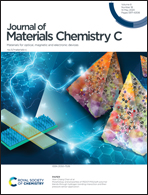Mimicking the competitive and cooperative behaviors with multi-terminal synaptic memtransistors†
Abstract
Spatiotemporal learning and inference in parallel mode is the key advantage for neuromorphic computing, which mimics the human brain architecture. Here, a memtransistor was fabricated with a self-assembled layer of 3-aminopropyltriethoxysilane (APTES) to mimic the synaptic behavior. The aggregates due to the hydrogen bonding between APTES molecules during the self-assembled process could form a defect in the interface. In the memtransistor, the holes could be captured effectively through not only the gate electrode, but also the drain electrode, resulting in controlled carrier concentration in the channel. An obvious hysteresis window was found by applying the operation voltage to the drain electrode. To study the competitive and the cooperative behavior, a multi-terminal memtransistor was prepared, and these synaptic behaviors could be successfully imitated. Finally, an artificial neural network based on the weight updating method was simulated to discriminate the numbers, and the total accuracy reached 96.42%. The results demonstrated that the APTES-based memtransistor had potential applications in synaptic electronics.



 Please wait while we load your content...
Please wait while we load your content...